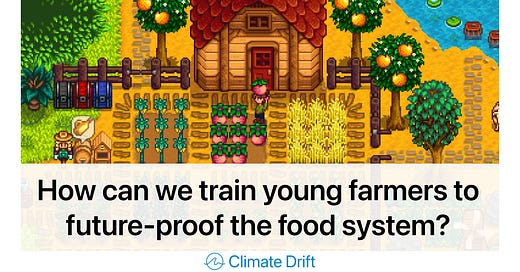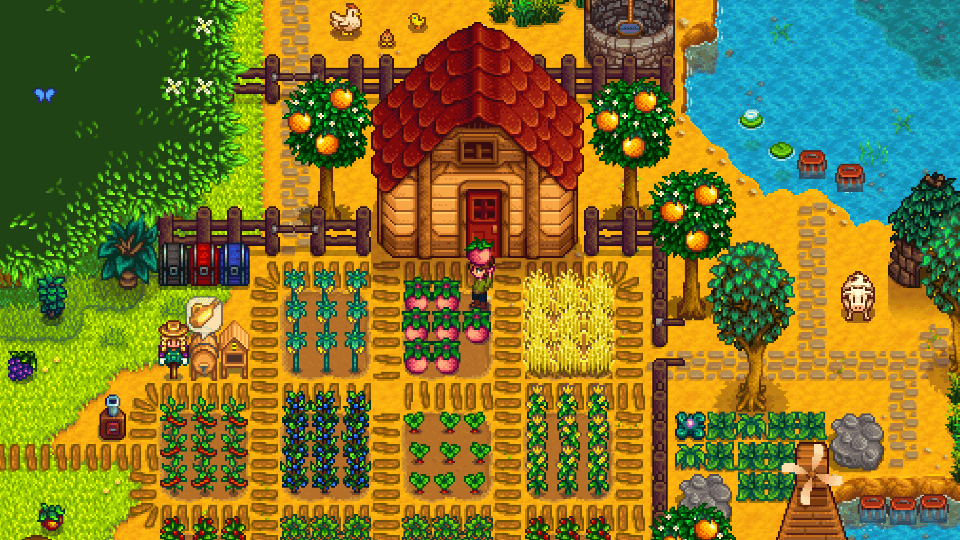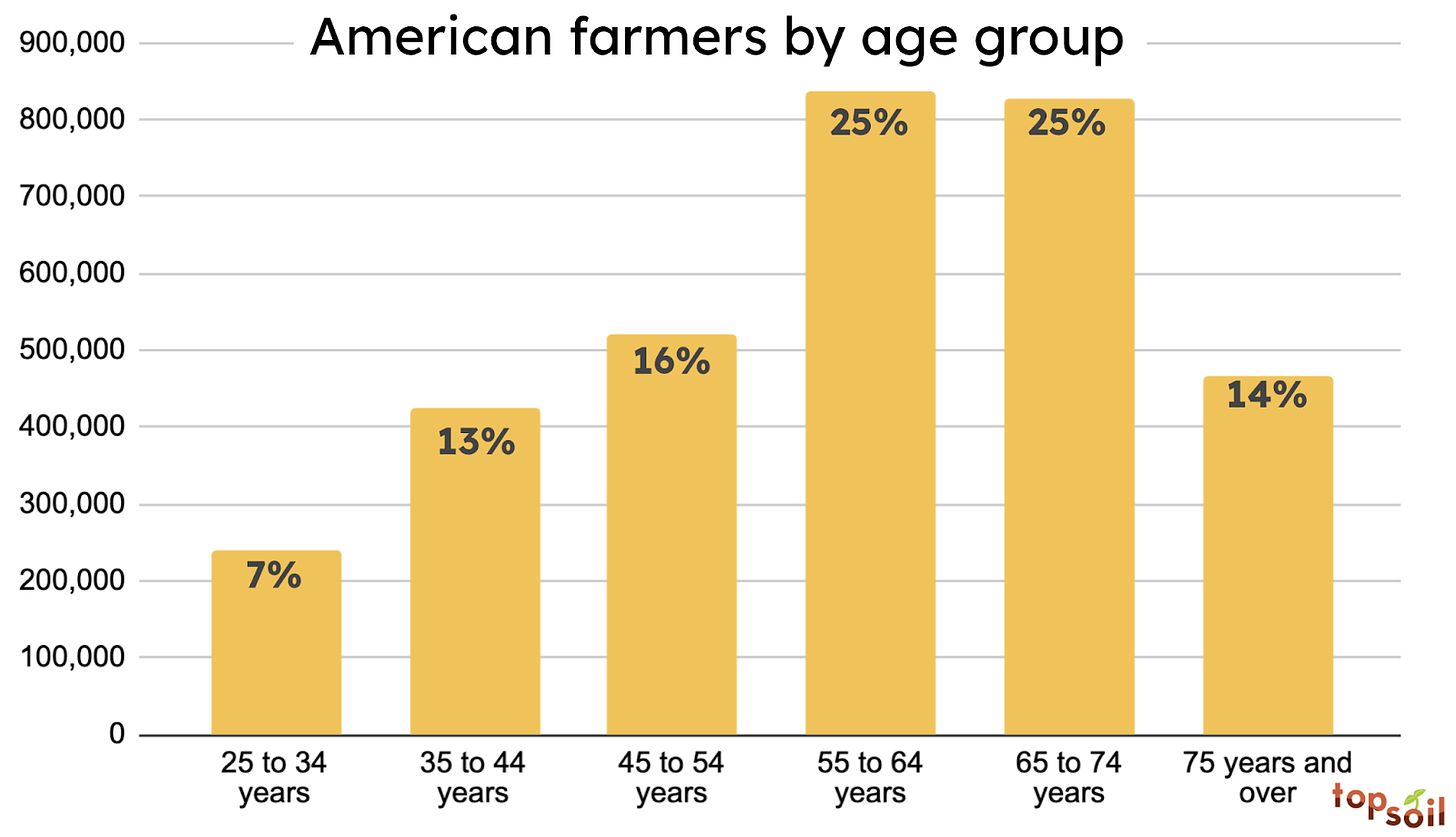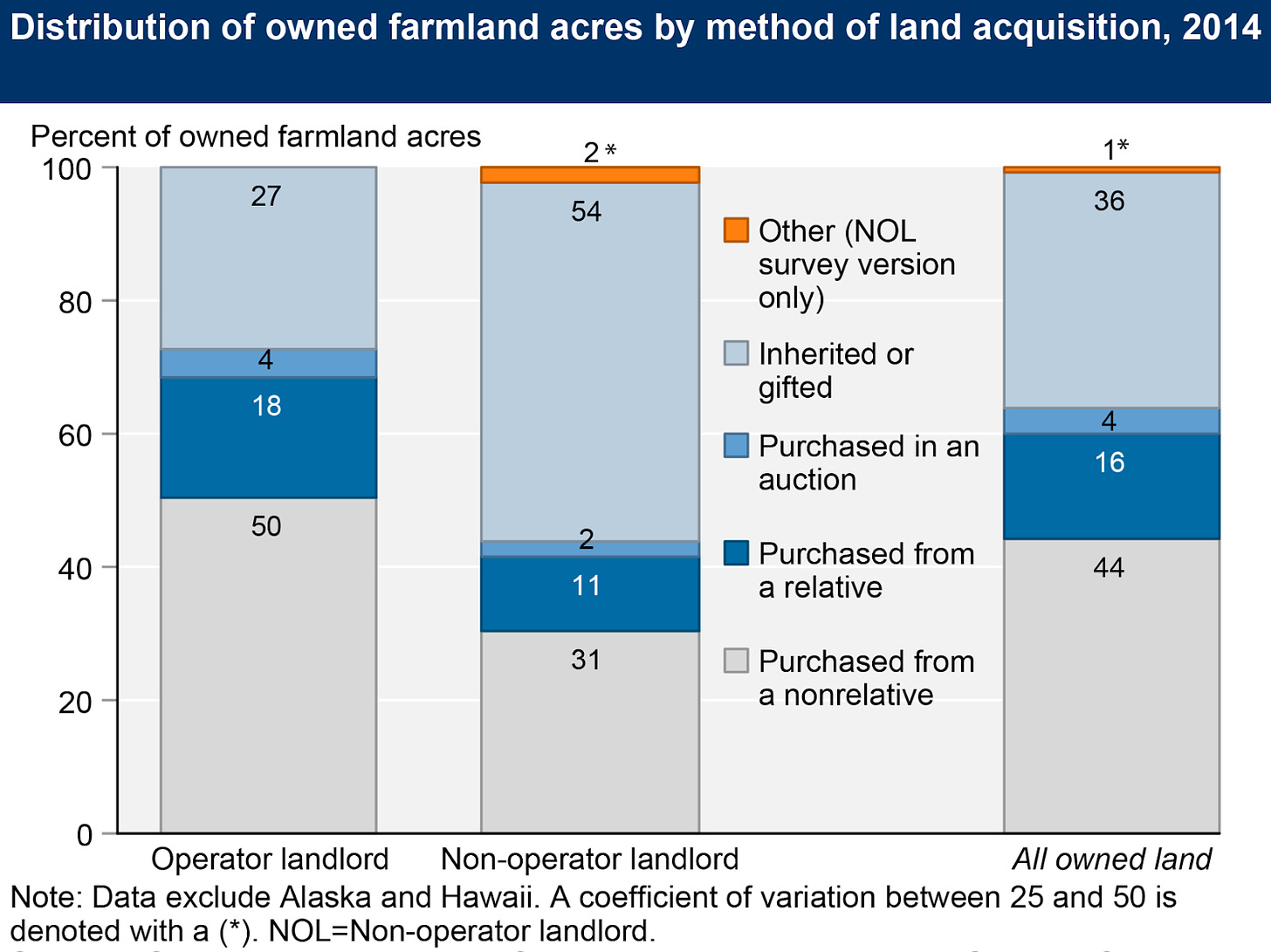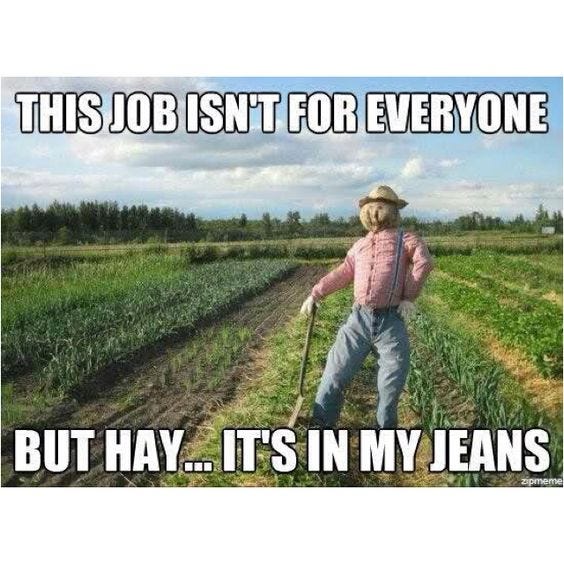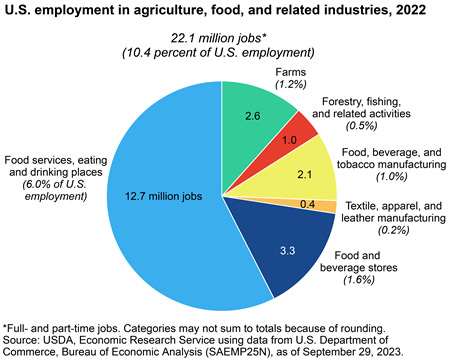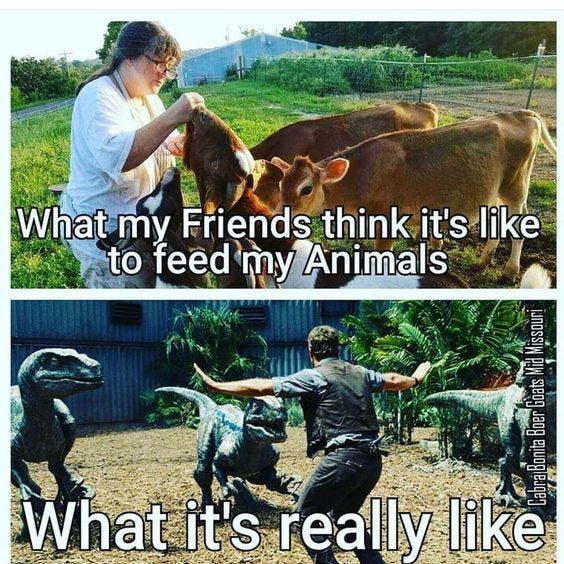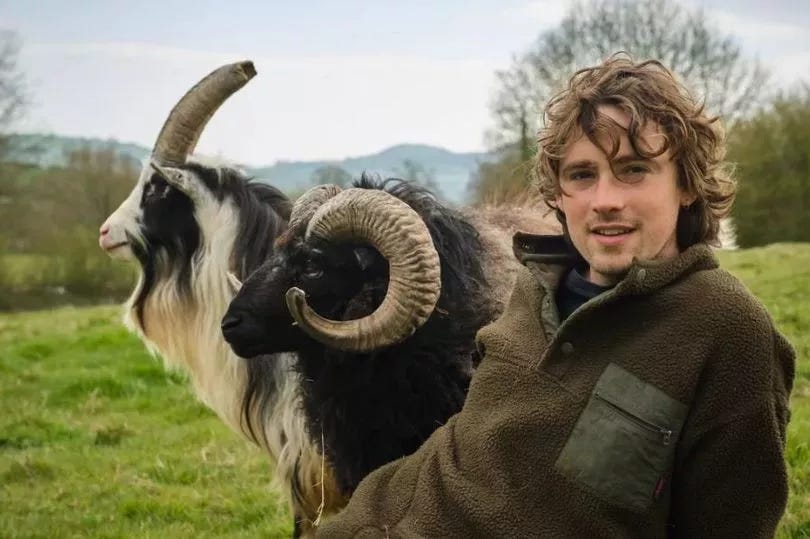How can we train young farmers to future-proof the food system?
Cultivating the next generation in an era of climate change
Welcome to Climate Drift - the place where we dive into climate solutions and help you find your role in the race to net zero.
If you haven’t subscribed, join here:
Hey there! 👋
Skander here! Today we're diving with Driftie Helen into a crucial but often overlooked aspect of our food system: how to train the next generation of farmers in an era of climate change.
In this deep dive, we'll explore:
The current state of farming in the US, including the aging farmer population
The challenges young farmers face, from land access to climate unpredictability
The role of technology in modern farming
The potential of regenerative agriculture and its economic implications
Creative solutions to attract and train young farmers, including a proposed farming academy
We'll unpack the complexities of modern farming, the importance of proper training, and the often-underestimated potential of young farmers in future-proofing our food system.
🌊 Let’s dive in
Join the Climate Drift Accelerator and accelerate your climate journey. We are selecting people for our next cohort now, and we're looking for talented individuals like you to make a real difference.
🚀 Apply today: Be part of the solution
But first, who is Helen?
Helen Hollyman is a James Beard award-winning journalist and brand strategist with a deep knowledge of food systems. She’s the founding Editor in Chief of MUNCHIES at VICE Media, the world’s first global Millennial digital food platform where she helped launch the culinary careers of personalities like Matty Matheson and Action Bronson. From inception to leading the MUNCHIES brand for five years, Hollyman grew the brand’s operations from a team of 5 into an international team of 50 staff with an audience over 20+ million during her time at VICE.
More recently, she was Editor in Chief at Thrillist, where she led editorial operations through a rebrand to reach younger audiences. At the height of the pandemic, she brought in $30 million in revenue for Thrillist through editorially-driven content. She’s won multiple James Beard awards, Webby awards, and was nominated for an Ambie for her true crime conservation podcast, “The Paddlefish Caviar Heist.” Hollyman is a volunteer farmer who is driven by a passion to work on projects about accelerating regenerative farming practices, circular businesses, reframing the notion of “food waste,” getting as many young people into farming, and weaving the systematic gaps between the “foodie” side of the food system with its other key players. She writes a substack that bridges the connections between regenerative farming and city-dwellers.
How can we train young farmers to future-proof the food system?
Pick up a Nintendo Switch and boot up the video game Stardew Valley, and within a few seconds, you’ve instantly become a young farmer with a potentially lucrative inheritance: your grandfather’s once bountiful, now decrepit farm. The potential to transform lifeless fields into rich, pixelated biodiverse landscapes and tending to fertile crops is just one button push away. And while the game is a simulation steeped in sheer entertainment, the premise is too close to the actual realities that American farmers face today: they are becoming too old to future-proof our food system in the fight against climate change ahead.
But before you close your tab and call this piece offensively ageist, hear me out. The average American farmer is 57 years old, leaving only 8% of the farming workforce under the age of 35. In Europe, it's even worse, where young farmers make up 5.6% of the workforce. To put it in perspective, farming was all the rage at the beginning of the 20th century, when farmers made up 30% of the American workforce. As agriculture turbocharged into industrialized methods to keep up with the growing global populations, these numbers rapidly decreased. Today, farmers only make up about 1.2% of the American workforce with farms that are more expensive to purchase than ever. Meanwhile, on any given day, Stardew Valley’s worldwide gaming community has more than 70,000 streamers worldwide, averaging at least 120,000 players in a 24-hour cycle.
Unlike the zero stakes qualities of overturning digital fields into fecund, profitable crops on a Nintendo Switch, for IRL young farmers under the age of 35, 81% are still incredibly green to the industry, having just started out in their farming careers in the last ten years. The current economic model of the farming system doesn’t align with the inherited challenges that young farmers face in the seasons ahead, from land access issues, barriers to capital, and other resources to help them get started. And with the unpredictable and volatile nature of future weather events caused by climate change, this green workforce has very little support in adapting and future-proofing one of the most vulnerable industries on the planet. Just ask household names like Heinz ketchup about the stability of tomatoes for ketchup in the face of climate change or the legendary California rice farmers at Koda farms, which just shuttered their 100 year old business due to issues that include the soaring cost of water, surge in insurance premiums, a small and aging labor population, and a crop, KoKuho Rose Brown Rice—which can be found on every hipster LA restaurant menus, ahem, Sqirl—that’s too tall, too slow-growing, too low-yielding for the weather conditions ahead.
TL;DR: Young farmers—under the age of 35—only make up 8% of the American farming workforce
Farmers make up 1.2% of the American workforce and yet Stardew Valley’s gaming audience averages 120,000 players in a 24-hour cycle
Companies like Heinz are struggling to keep up with maintaining crops for household items like ketchup given unpredictable and shifting weather patterns
100 year old companies like Koda Farms are going out of business due to water insecurity, lack of labor to help, and surging insurance premiums connected to climate change patterns
United States farms are a major player in the global economy and global food pantry, contributing to 25% of the world’s grain supply. Farming provides $300 billion in crops, livestock, and seafood to the US economy annually and $750 billion to the U.S. economy with the additional food-service and other agriculture-related industries. But with America’s groundwater drying up, crop yields are dwindling and many farmers are being forced to dry farm to adapt to the rapidly diminishing growing conditions.
If you ask Emily Buckman, Director of Government Affairs at the American Farm Bureau Federation, labor is the number one concern for future agricultural production in the U.S.. Federal programs such as the USDA’s Working Lands Climate Corps (WLCC)—in partnership with the Biden Administrations American Climate Corps program—are an excellent start in providing technical training and climate-smart agricultural solutions for farmers, but the volume size of trainees for young farmer climate resiliency across the country needs to be met at warp speed if we’re to race against the climate clock at equal footing ahead.
And while the size of American farms is increasing, acquiring land, equipment, and capital can create incredible barriers to entry for young people starting out in the industry who are already grappling with the financial burdens of student loan debt, housing shortages in rural areas, and lack of child care.
But young American farmers possess ingenuity and have embraced new economic models by having a primary occupation outside of farming to pay their bills. Farming has become their full-time side hustle. According to the 2022 agricultural census, young farmers are most involved in the day to day farming decisions—including land use and crop decisions—but 64% have a primary occupation outside of the farm because agricultural sales are not providing them the same returns that have benefitted previous generations. This young workforce is making up 15% of all U.S. agricultural sales and 12% of farmland.
TL;DR: U.S. farms contribute to 25% of the world’s grain supply
U.S. farms are a major player in global economy: contributing $300 billion in crops, livestock, and seafood to the US economy annually and $750 billion with additional food-service and ag-related industries
Labor is the number one concern at the American Farm Bureau Federation
64% of young farmers have a primary job outside of their full-time job farming just to make ends meet because agricultural sales aren’t providing the same returns previous generations benefitted from
Challenges: The Farming Landscape Ahead
Climate change is expected to disrupt food security at global, regional, and local levels. Food, agricultural practices, and land use contribute to 22% of global greenhouse gasses and help to drive the global economy. The steady depletion of natural resources threatens the long-term productivity of food systems, with climate change further exacerbating supply chain volatility and endangering farmer/producer livelihoods. And as an inherently climate-dependent industry, agriculture has been among the first to experience the destructive impacts of rising temperatures, changing hydrologic cycles, and extreme weather events.
Stop blaming farmers for your expensive groceries
It goes without saying that farmers are heroes. They’re on the front lines of transformation, seeding, growing, and tending to crops to ensure our bellies are full with a diversity of options that eaters don't often appreciate the energy that goes into the box of cereal in front of us. But they’re still getting a bad rap, and the media is to blame. American grocery prices are 30% higher than during the pandemic and are here to stay because of the consolidated consumer packaged goods companies that own the majority of household name brands. Unfortunately, farmers often get the blame for these prices, which are completely out of their control. Eggs, coffee, margarine, and soup are among the hardest hit in the “Shrinkflation” effect of brands selling smaller amounts of product than before to meet the rising costs of ingredients and manufacturing that has been unfolding in CPG brands long before the covid-19 pandemic.
While the environmental conditions around us are shifting, our concept of the American farm in the cultural zeitgeist is disappearing altogether. Every day, more than 2,000 acres of farmland are being lost to real estate development and farm consolidation is changing at warp speed. Up to 40% of US farmland (approximately 370 million acres) could change hands in the next two decades, leading to potential vulnerabilities in biodiversity, crop diversity, and land use. As of 2014, about 1/3 of American farmland is owned by non-farmer landlords like Bill Gates, and over the next 20+ years, more non-farmer landlords are likely to determine the future of these spaces. Farm consolidation will further reshape our broader agricultural ecosystem environmentally, economically, and as a national industry in global food security.
Over the past 30 years, an estimated USD 3.8 trillion worth of crops and livestock production has been lost due to disaster events, or an average loss of 5% of annual global agricultural GDP. To put it into perspective, it's an average USD 123 billion per year, or 5 percent of annual global agricultural GDP or 69 million tons of cereal, 40 million tons of fruits and vegetables, and 16 million tons of meat, dairy products, and eggs lost annually.
And with the rapidly increasing frequency and severity of climate events to come, farming conditions will only worsen under the “business as usual” scenario with the current continued approach of conventional agricultural production methods.
TL;DR: Food, agricultural practices, and land use contribute to 22% of global greenhouse gasses and is one of the most climate-dependent industries
Shrinkflation—the rising cost of ingredients and manufacturing—are causing expensive grocery prices but farmers get the blame for it
Farm consolidation, farmland loss to real estate development, and non-farmer farm landlords like Bill Gates are reshaping our broader agricultural system—a dissonance that threatens our global food security
Climate change is bad for the economy: an estimated average 5% loss of annual agricultural GDP that will increase without crop adaptation and innovation
Farm Anxiety, Labor, and Recruitment problems ahead:
In 2024, we are experiencing a global economic crisis: Even within affluent G20 countries, high inflation rates and rising housing costs significantly eroded much of the recent nominal wage gains in 2023-2024. American farmers are 3.5 times more likely to die by suicide than the average U.S. population, and their children are suffering the consequences. In stewarding the next generations of farmers, 60.6% of U.S. farm kids are currently experiencing anxiety disorder compared to the 32% national adolescent average. According to Emily Krekelberg, an educator for farm safety and health at the University of Minnesota Extension, “In farming, there’s this culture that being stressed and overworked is a badge of honor. So kids, especially during busy times on the farm, like planting in the spring and harvest in the fall, they see this idea really being normalized and with maybe not much priority placed on vacations and rest and just taking time to relax.” Krekelberg trains people in suicide prevention to accident avoidance and more.
Coupled with the shifting and unpredictable nature of climate change and the mounting task of a rising global population that’s expected to increase to an estimated 9.2 billion people by 2040, food production methods and the farmers who produce them are going to be forced into overdrive production in the next fifteen years.
Will AI Replace Farm Worker Jobs? The Pros, Cons, and Realities of when the wi-fi cuts out
AI is simultaneously an environmental disaster and a way to advance climate solutions. A single ChatGPT conversation uses one plastic bottle’s worth of water but can map so much more. With the shifting environmental challenges that climate change presents to aging farmers, AI has become one of the most rapidly dominant resources in agronomy today, but is falling short of its potential due to lack of human resources. The US labor shortage is an ongoing issue that deeply impacts our agriculture production and economics. As of 2021, 87% of U.S. farm businesses have been using AI and the government is helping to incentivize funding to speed up adaptation to AI practices on farms across the country, but the labor pool is more expensive than ever due to several reasons, including rising state minimum wages, fewer newly arrived unauthorized workers, and new requirements to pay overtime wages to some farm workers.
AI has the incredible potential to help solve aspects of the ongoing farm labor shortage, but it comes with limitations that will never replace human ingenuity. Machine learning strives at predicting crop disease and extreme weather events, crop health, soil health, irrigation, pest and weed control and fertilization, but it relies on consistent wi-fi connections, which isn’t always prominent in rural farming communities. It’s bad at creative thinking and will never replace human skills that small to midsize farmers brilliantly employ on the fly. And while some aspects of farming and ranching are already highly mechanized, there are still many farming tasks that require human judgment and dexterity, like monitoring crops or caring for livestock.
One of the big pledges AI automation poses right now is a reduction in labor costs on farms, but less than ⅓ of farmers recently surveyed by CropLife/Purdue said it would reduce their labor needs associated with crop inputs. So while AI won’t actually replace the agronomists, it can better support them in making better climate adaptive decisions in a collaborative effort to support the next generation of young farmers with training.
TL;DR: American farmers are 3.5 times more likely to commit suicide than the average American and farmkids are experiencing anxiety 60.6% more than the national average kid at 32%.
The rising global population is expected to increase to 9.2 billion people by 2040 → forcing food production methods into overdrive production in the next 15 years
Labor pool is more expensive than ever and 87% of farm businesses are using AI due to government incentives but comes with great limitations
AI relies on wi-fi which isn’t always available in rural farm areas
AI is bad at dexterity and human judgment like caring for livestock or monitoring crops
AI automation pledges to reduce labor costs but less than ⅓ of dealers said it would actually reduce their labor needs associated with crop inputs
Cracking Knuckles, Creating Creative, Lucrative Solutions:
For financiers, transition investing in regenerative farming is an approach to future-proofing their investments through adapting value chain investments to changing climate conditions, but this will require a skilled workforce who understands these elemental challenges to unlock grounded white space opportunities. The transition required to shift into regenerative agricultural practices and climate adaptive food systems will unlock new economic opportunities for financiers who understand the ecological volatility right now. However, this funding gap to shift conventional global food systems to regenerative practices is estimated to take between USD $250—$430 billion annually over the next ten years. According to The Rockefeller Foundation, closing the financial gap would unlock USD $4.5 trillion in new investment opportunities per year (~13x the investment cost) and $5.7 trillion of costs per year saved in damages to people and the planet (~16x the investment cost).
In a world where the rapidly growing consumer demand for regenerative food products is at an all time high, the shift from industrial farming methods into organic and regenerative methods for producers has a wealth of incentives with longer tail economic opportunities. Regenerative farming increases organic soil matter, improves water retention, and enhances biodiversity to better withstand extreme weather events to provide producers with a buffer against climate change. To meet the growing demand for organic, regeneratively and locally grown food may create new opportunities for small-scale farmers and producers.
TL;DR: Mind the funding gap: Financial white space opportunities involves transition investing into regenerative farming practices to future-proof investments
This investment space needs a skilled workforce who understands the changing climate conditions
Consumer demand for regenerative food products is at an all-time high that has a wealth of incentives for longer tail economic opportunities
Gen-Z is leaving white-collar opportunities and flocking to blue collar jobs in droves
Young people are looking for meaningful work that is fulfilling, impactful, and fair. Data from a recent report published by the International Labour Organization states that one in five young people are unemployed, education, and training, and the lack of investment in creating education and work opportunities for young people could cost the global economy $83 trillion by 2030.
Focusing the lens towards the growing economic challenges in the American economy are driving Gen Z into becoming a blue collar workforce, from their concerns about artificial intelligence impacting white-collar roles to the appeal of job security and the potential for higher earnings without the burden of college debt. And while the supply chain for industrial agriculture is developed and mature, regenerative agriculture’s supply chain is undeveloped and nascent and ripe with opportunities that need to be addressed by training a green labor workforce from every level of farming: upstream, midstream, and downstream. According to a recent study from BCG, transitioning to regenerative agriculture from industrialized farming could result in a 120% increase in profitability for farmers, significantly improving the quality of their livelihoods. Farms with high-quality, low erosion soils have been proven to experience less crop loss in extreme weather events, and unlike the approach to monocropping, employing the regenerative technique of intercropping provides economic resiliency when one crop fails.
Financial opportunities to scale regenerative practices include transitioning growers from industrial to regenerative agriculture practices. According to Creo Syndicate, these transitional scenarios for farmers and manufacturers can be met with moderate adjustments— a farmer, for example, can use the same tractor but might need new seeds for crop diversity and manufacturers can use the same freezers but might need new processing lines for regenerative certification.
TL;DR: A recent study from ILO suggests that young people are looking for meaningful, impactful and fair work and not investing in their education and employment opportunities will cost the global economy $38 trillion by 2030
Gen Z is becoming a blue collar workforce who wants to shake off the burden of student loan debt
Farmers who transition to regenerative ag from industrialized farming could result in a 120% increase in profitability
Transition farming can be met with moderate adjustments for farmers
Financial Gains in the Mid-Stream: Disrupting Norms for a Brighter Future
Industrial agriculture’s supply chain is highly developed and is currently prosperous but experiencing climate adaptation at warp speed as companies such as Heinz are racing against rapidly shifting climate conditions to regulate household brand names. In deep contrast, the regenerative farming supply chain is very undeveloped and yet one of the exciting white space opportunities for financiers is to create regionally-centered midstream infrastructure development in emerging markets where it is currently lacking to scale organic and regenerative farming practices.
Last year, I experienced this first hand as I joined Climatebase’s Cohort 3 Fellowship, where I led a team of five to produce a Capstone research project to explore business opportunities around building a CPG food company to drive consumer awareness around regenerative farming. My desire to build my own business was inspired by the Ellen MacArthur Big Food Redesign report and was focused on synthesizing my skill set from spotting and setting culinary trends for foodie culture with my culinary network of notable chefs and farmers together to rethink and revalue what ingredients can be used to design nature positive impacts. Our team interviewed a wide set panel of 15 small to mid-sized farmers about their greatest mid-stream market challenges. Our research analysis gave me the takeaways that regulatory challenges, lack of regional processing facilities, and resource scarcity were the greatest barriers to scale upwards.
The lack of regional processing facilities blocks many farms trying to scale their operations from breaking through to the next threshold due to higher transportation costs, leading to revenue loss from premium organic or regenerative products. These barriers often result in the products having to be sold off as “industrial crops” at much lower prices, even if they are organic or regeneratively grown.
The midstream supply chain has the least investment activity with some of the greatest potential for unlocking consumer growth. According to CREO Syndicate, regeneratively-grown foods and products will be sold at a premium price to consumers, who in return, expect positive environmental impacts that come with full transparency. The long-term viability of potential requires a funding gap that allows for smaller supply chains, regional processing facilities, and dynamic food CPG companies to envision and enact this shift.
TL;DR: White space opportunity: Create regionally-centered midstream infrastructure development in emerging markets to scale organic and regenerative farming practices
What I learned from trying to create my own food CPG company: Using a diverse set of regionally-focused crops with smaller supply chains can yield successful results
Consumers are game to pay a premium price for regeneratively sourced products that requires full-transparency
Consumers are one of our secret weapons to working with future farmers
It doesn’t take much to reflect on current TikTok trends like the Stanley Cup craze or the ongoing drop culture of cult brands like Supreme or Palace to emphasize the impact of consumer demand in driving the food system transition. Over the next 20 years, the potential transformation of environmental gains have massive potential if the consumer demand is carefully unlocked to support organic and regenerative food practices. According to regenerative investor and entrepreneur Anthony Corsaro, “to me as the consumer, if you look at the data on growth in the set, and you look at Gen Z, millennials and the kind of products that they’re demanding, this is going to be super important.” Even Paul Lightfoot, General Manager of Patagonia Provisions, agrees that consumers are the key lever to change, but redirecting existing farming infrastructure to better use is the way to scale towards regenerative agriculture. And whether or not wellness brands like Goop lead the charge on educating consumers about the link between gut health and soil health, the consumer demand for more nutrient-dense, healthier foods is already here.
TL;DR: Stanley Cup craze: Look at TikTok trends to understand the impact of consumer demand in driving the food system transition
Consumer demand for nutrient-dense, healthier foods is here → better soil health = better gut health
RFS: Companies that new farm programs can glean from
In a request for startups, there are a few climate industry programs that the agricultural space can glean great inspiration from in addressing training a new generational farming workforce into climate resiliency. Here are a few examples for inspiration.
ECOWIND: Japan’s offshore wind is the country’s most promising renewable energy source, and scaling it quickly is going to require a large, highly skilled workforce. This year, the Japanese government announced ECOWIND: the Education Council for Offshore Wind to meet the holistic growth of Japan’s clean energy transition. The program will bring a council of government, industry, and academia together to formulate a new framework for developing the workforce that’s needed for this nascent sector. ECOWIND will work by connecting firms with students, matching the educational needs of offshore wind with technical colleges and universities and will include site visits and lecturers for on-site classes at schools, internships for students, fostering public understanding of offshore wind power, and strengthening the ties across regional industry-academia activities.
The Aira Academy: According to the UK Parliament’s research, in 2022, the country had just 3,000 qualified heat pump engineers but the government estimates that by 2028, the country will need to have at least 27,000 installers to meet the national installation target of 600,000 heat pumps per year by 2028. Due to recent government incentives, there is an anticipated heat pump surge doubling in the decade to come. Swedish clean energy-tech company, Aira, has committed to hiring 8,000 clean energy roles over the next decade to help in the heat pump transition. And in order to meet this transition, AIRA has launched the heat pump training academy in London, where it plans to provide training for thousands of heat pump sales specialists, installers, and electricians over the coming decade to meet the need of employing clean energy roles in the next ten years.
Climate-Ready Workforce Initiative: In the United States, the National Oceanic and Atmospheric Administration initiative is funding $60 million to 9 different projects over four years across the U.S. to train professionals for jobs that increase climate resilience. The selected projects will support training and skill development for jobs such as solar installation in California, dry floodproofing that makes building walls watertight in Louisiana, and water and wastewater treatment operations in American Samoa. The training and skill development required to fill these various industry gaps will change over time. As the sustainable sector expands, the skills once considered specifically useful for climate resilience jobs will likely move into other industries, making them more essential to a wider scope of workers.
TL;DR: Government, industry, and academia have to work together to create academies that provide new tools for new workforce facing unprecedented conditions
How to Put the Fun Back in Farming…
OK, so let’s cut to the chase: In our current world, where it feels the more technologically refined human society gets, things are fissuring between communities that want to feel connected to the land, ahem—I see you, Michael Pollan and Paul Stamets—and folks that want to dissociate based on the increasingly insurmountable challenges posed by climate change by colonizing other planets, or just sinking deeper into the internet void, how do we actually motivate current and future generations of young people to take on one of the most physically, emotionally, and environmentally demanding jobs that (currently) pays terribly in the universe? Sometimes, the romance in glorifying the darkest realities of what is often overlooked underrepresented becomes mainstream as part of collective culture. Creating visibility through the lens of powerful cultural voices like Anthony Bourdain, for example, inspired a generation of new line cooks.
Riding the wave of foodie culture’s zenith at MUNCHIES made me wonder why we still haven’t yet cracked the code on spotlighting stories across the food chain in more meaningful ways, and yet we’re still willing to spend countless hours watching Top Chef, Chef’s Table and searching for #foodporn on Instagram (as of 2024, 250,000,000+ users searched for that term on the platform).
The Hipsterification of Farming: Does it work?
I know what you’re thinking though: Helen, there are existing tv shows about farmers and the romance of it all out there. Tropes like the chef who traded the bustling city in order to live off the land, exercise self-reliance and connect more with nature is certainly nothing new. Long standing British television chef Hugh Fearnley-Whittingstall showcased it all in his popular River Cottage series on Channel 4 in the UK, which has since blossomed into a legendary brand that includes multiple cookbooks, a restaurant and fork to table business, and more. TikTok/Instagram famous Julius Roberts, has carried that same narrative torch into 2024. The 25 year old London native is a first-generation farmer and restaurant trained chef who left the city after an 8-month gig at Noble Rot, one of London’s amazing dining spots, to start his own farm on the Dorset coast. When he’s not doing #sponsoredposts that likely make up a large portion of his income stream (thanks to his 1 million plus followers), Roberts is selling cookbooks, his own food products, sheep skin, and a written newsletter. Television shows like Clarkson’s Farm in England and Let’s Farm in China have shown how gravely challenging (and expensive) it is to become a farmer unless you are extremely wealthy or have some sort of inherited wealth, such as Hannah Neeleman of Ballerina Farm. She’s the face of American trad wives who effortlessly milks cows straight into her coffee cup, feeds her livestock and still finds the time to make dinner for her 8 children on her 328-acre farm. Neeleman’s husband Daniel is the son of Jetblue’s billionaire founder David Neeleman.

FarmTok: Meet the Millionaire “Farmers” Showcasing the Romantic Side of the Business
The last 7+ years that social media has had in turbocharging massive audiences with impactful monetization gains for amateur influencers and longstanding craftsmen, too, overnight, is a gamechanger in positive and negative ways on society. Agricultural companies like John Deere are adapting to the potential marketing value in recruiting Tik Tok #Farmtok influencers to inspire the next generation of young farmers by hiring their first “Chief Tractor Officer,” (a TikTok creator) to stoke a new generation of tractor users. Spend less than one minute watching Millennial Farmer Will pull a sheep out of mud or Lacy M Evans snuggling with her cows or Montana rancher Emmy Sperandeo throw hay to cattle in designer wear to make you wonder if you’ve got the chops to pull a Billy Crystal a la City Slickers, quit your soul-sucking day job and start a new life on a farm somewhere remote. But with all this content that these farmers and ranchers create—between their sponsored posts, book deals, newsletters, and countless hours of editing, how do they do all of that and maintain their farms?
TL;DR: Television programs that aim to celebrate the romantic side of farming often fall short of showing the harsh realities that farmers face
Millionaire influencer personalities like Hannah of Ballerina Farm or Jeremy Clarkson of Clarkson’s farm have the financial ability to farm without the traditional farming pressures and receive financial gain from the tax writeoffs of owning a farm
The realities of being a #FarmTok influencer—from sponsored content posts to book deals and tv shows—impact farm maintenance


Japan Is Borrowing from Drop Culture to Get Young People into Farming
In Japan, the farmer population is one of the oldest in the world, at an average age around 67. Luckily a group of young farmers has come up with an antidote to the national farm labor crisis by forming Shiki Farmers Club, which seeks to shift the agricultural farmer image and make it an attractive job that new generations of Japanese youth aspire to become. Their efforts to achieve this image impact include strategic, beautifully designed seasonal CPG product drops, Shiki Farmers Club exclusive CSAs, and merch.
The Path Ahead: How I’d Boost Young Farmer Percentages from 8% to the Moon
In reality, most farmers don’t have time to become internet famous because they’re too busy planting, tending to, and managing all of the food and ecosystems each of us benefits from. Talk to any young American farmer about their current challenges, and they’ll likely allude to their barriers to land access, market access, capital, or labor. There’s no question we’ve got incredible agricultural collegiate programs at top-tier schools like Cornell, Texas A&M, and UC Davis to provide exceptional undergraduate and graduate training programs, but as I mentioned earlier, millennials, Gen Z, and future generations are/will be struggling with student debt. And for high school graduates who don’t have the financial means to attend university (or don’t want to), there’s got to be a program that supports, trains, and immediately onboards them into the agricultural sector with a bit more ease.
Here’s how I’d do it:
To accelerate the rapid growth of a new class of young farmers, whether you’re right out of high school or have a few years of experience under your belt, creating a farming academy that collaborates with government, industry, and academia to provide new tools and training to meet the needs of this new workforce facing unprecedented conditions is key.
This academy would focus on training thousands of future farmers at every level of the process—recruiting high school graduates, college students and early stage workforce professionals. The coursework would focus on introducing new tools to meet shifting conditions, from the farm itself to mid-stream processing, sales, land management, communications, business ops, crops and climate resiliency. This academy’s efforts would focus on training not just farmers but also key farm stakeholders across the system in great volumes. Upon completion of the academy, these students would have a direct landing into jobs. This is a place where companies like Heinz present their crop challenges as an opportunity for students to collaborate and develop new CPG products, supply chain issues, crop adaptation strategies, and spot trends that younger generations are craving. The academy could partner with content creators from FarmTok and other farm influencers to develop a channel strategy of to recruit new students by showcasing farm culture through various channels (social, television, etc).
And lastly, by partnering with existing programs like the FFA, 4-H, National Young Farmers Coalition, Farm Aid, Greenhorns, this academy would also be able to provide key thought leadership, mentorship and support across the agricultural sector. The academy could partner with culinary programs at the Culinary Institute of America to bridge chefs more easily with farmers to create compelling CPG products and mid-stream innovations to meet consumer demand. I’d be lying if I wasn’t waiting for a legendary organization like Farm Aid to have Zack Bryan partner with FarmTokers to create noise (and perhaps a fund) for the academy. As part of the academy’s infrastructure for farm graduates, it would have a fund (or easy resources) for farmers to lease land and get going with a built-in mentor network of retired farmers.
These are just a few suggestions on how to continue to germinate new generations to come, but farmers are heroes and agents of transformation and change on the front lines of climate change every day.
TL;DR: My solution is building a training academy that collaborates with government, industry, and academia to provide new tools and training to meet the needs of this new workforce facing unprecedented conditions
Goal: train thousands and thousands of students at volume and place them directly into jobs at the completion of the academy to meet the needs of demand
Academy elements would partner with key farming organizations and weave coursework to reflect climate unpredictability for both farmers and farm stakeholders alike: AI tool training, on the farm training, mid-stream processing, sales, land management, communications, business ops, crops and climate resiliency, and more
Academy is a place where big food CPG companies bring their supply chain challenges to collab/develop new products with students
Academy partners with farminfluencers to recruit new students and create visibility around farm jobs at every level of the supply chain
You can reach me here on LinkedIn or via email: [email protected].


